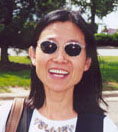| |
GaoMing
Welfare Institute, Guangzhou,
Guangdong Province, China - Page 2
 There
are 63 children cared for in the Home. Thirteen care givers take
turns looking after all the children all day long with a salary of about
550 yuan (Chinese dollars) a month and no other benefits. About
450 orphans are in foster care at present. Since the Home was founded
in 1952, there are some adult orphans working and living in the town who
come back to pay a visit once a while. There
are 63 children cared for in the Home. Thirteen care givers take
turns looking after all the children all day long with a salary of about
550 yuan (Chinese dollars) a month and no other benefits. About
450 orphans are in foster care at present. Since the Home was founded
in 1952, there are some adult orphans working and living in the town who
come back to pay a visit once a while.
Being driven by poor funding and encouraged by the policy, the Home is
now going to society by adopting some measures; asking for donation through
advocacy and opening a clinic for the children and the old aged inside
and outside the Home. This can save a lot of expenses on clinic
treatment for the residents as well as make money for improvements on
the Home by providing service for the neighborhood. One doctor and
two nurses are working at the clinic.
Now we are back to the Home again and allowed to take pictures and make
video. "Parents are eagerly awaiting to take a look at the home
where their beloved children were taken care of and living in the first
months of their life. This could be one of the ways to do advocacy
internationally" I told Mr. Li at the lunch table. I was not able
to take any photos before Mr. Li came back even though we were allowed
to pay a pre-visit to the children's section lead by Ms. Liang.
Lead by Mr. Li this time, we changed into slippers but not white uniforms
since there are not enough for visitors, and walked across a hallway and
stepped into a big room. There three older handicapped children
are walking around. Ms. Luo mentioned earlier that a couple of older
children went to the kindergarten across the lawn. Of all the children,
the oldest and only boy, (seven years old), in their care avoids us. All
the other young children, (from four months old to fourteen months old,)
are rolling in their walkers, (the same as I saw at the Shanghai Children's
Welfare Institution), here and there with their bared feet on the ceramic
floor. They are happy and smile once we touch and hold them. All
the infants are in one section, some of the babies are so young and tiny.
Their eyes and little fists are closed tightly and red faces are
dotted with baby wrinkles and frowned eyebrows.
Every child is wearing split pants with a cotton rubber band on their
hips, which is used for holding on their diapers. It is time to
change the infants. Muoyan and I are helping change several of infants.
Three mamas are busy changing, non-stop changing and washing, while
also checking on the babies to see if they had covered themselves with
blankets while waving their arms and legs.
The hall room is about 45 feet long and 20 feet wide, as measured by my
foot. Over fifty cribs are arranged in six rows and divided by a
huge counter that is piled with a mountain-like pile of diapers. A
mama is folding big pieces of gauze into small shape of diapers for changing
infants. On both ends of the hall room there are two small rooms.
One is used as an activity room where a dozen of infant baskets
are arranged against the wall. Two of the older handicapped children,
(3 and 5 years old, both deaf, one mental retarded), are rocking the small
ones in the baskets. The other room is used as a sanitary room.
There are several sinks for washing babies and a table for filling
formula into bottles. A mama is feeding young children sitting in
walkers with vitamin water. All of these children had their lunch
of rice or thick rice meal at the time when we came for the pre-visit.
- Continued
On Page 3 -
INDEX  1 2 3 1 2 3

|

